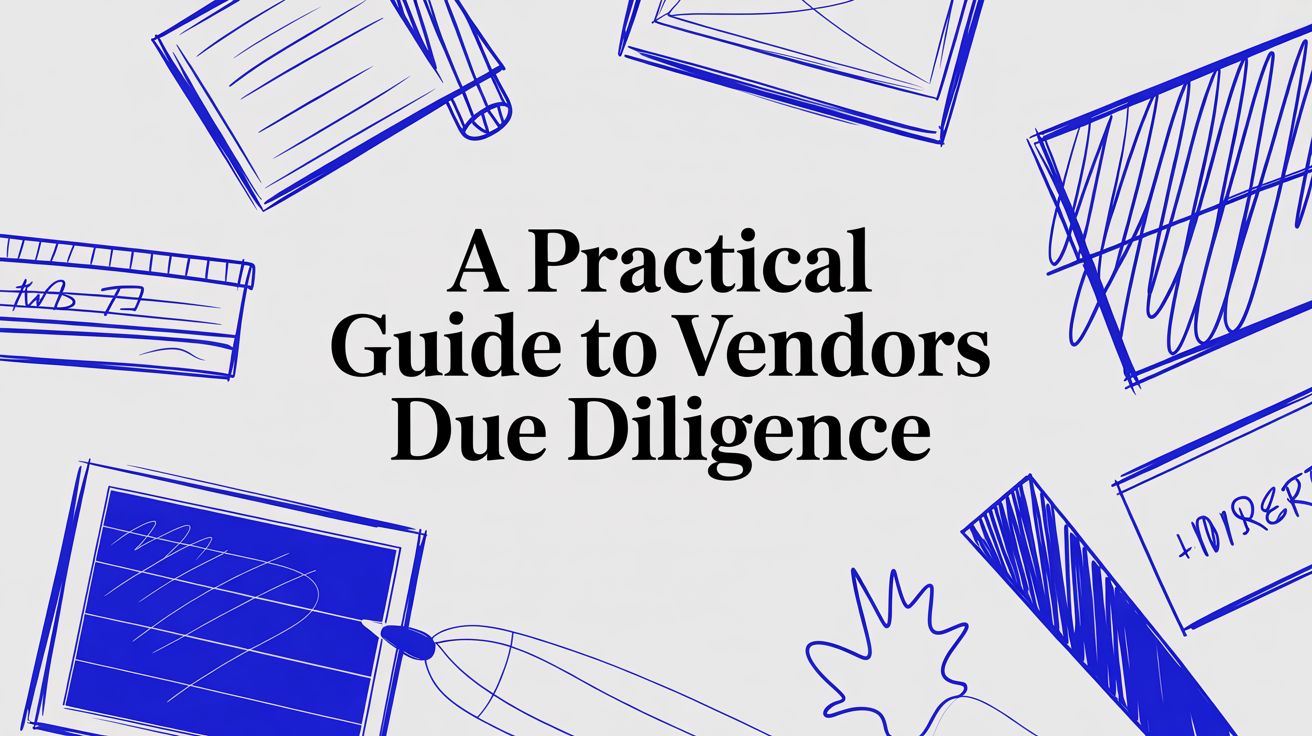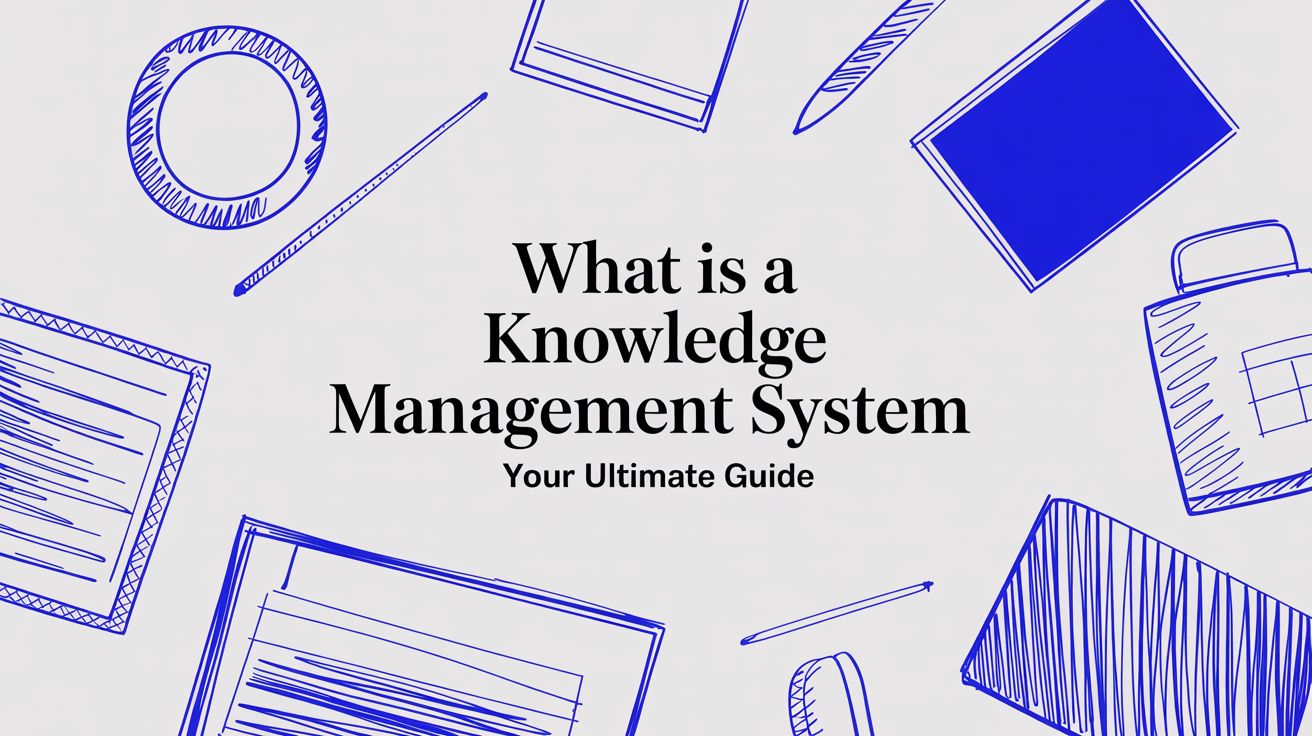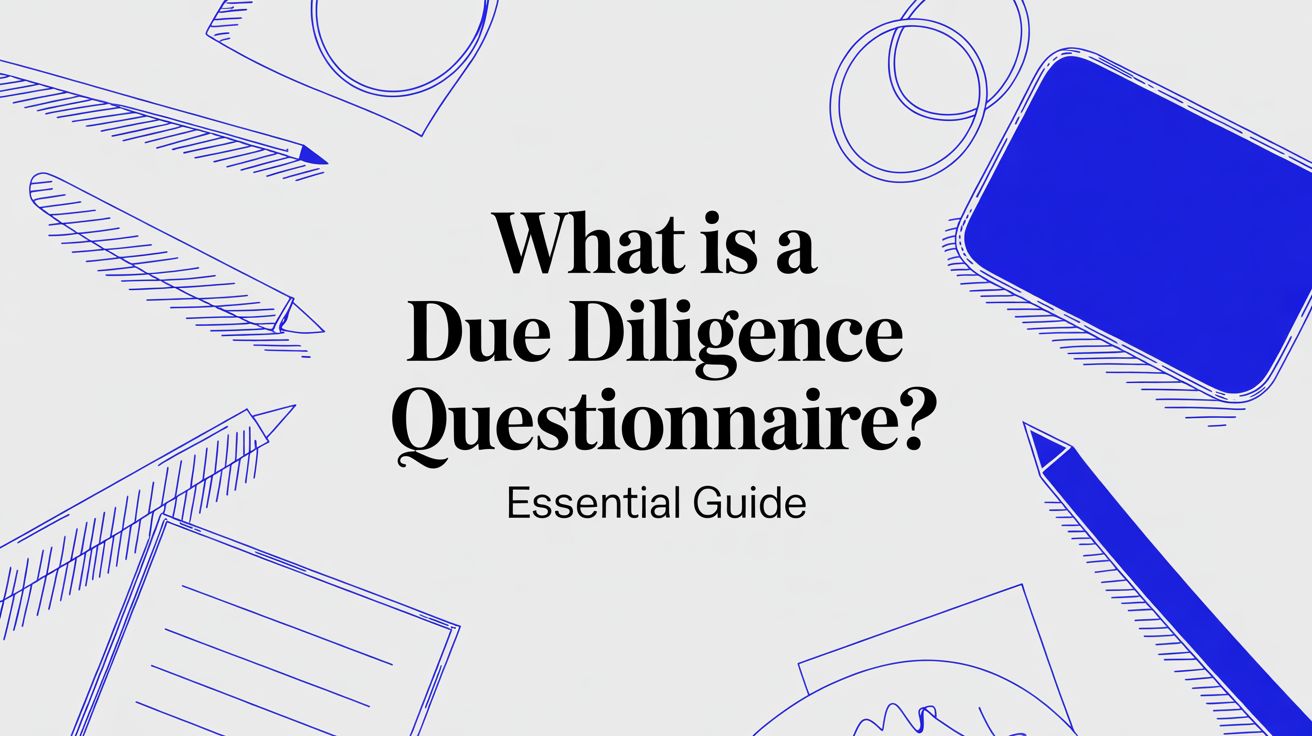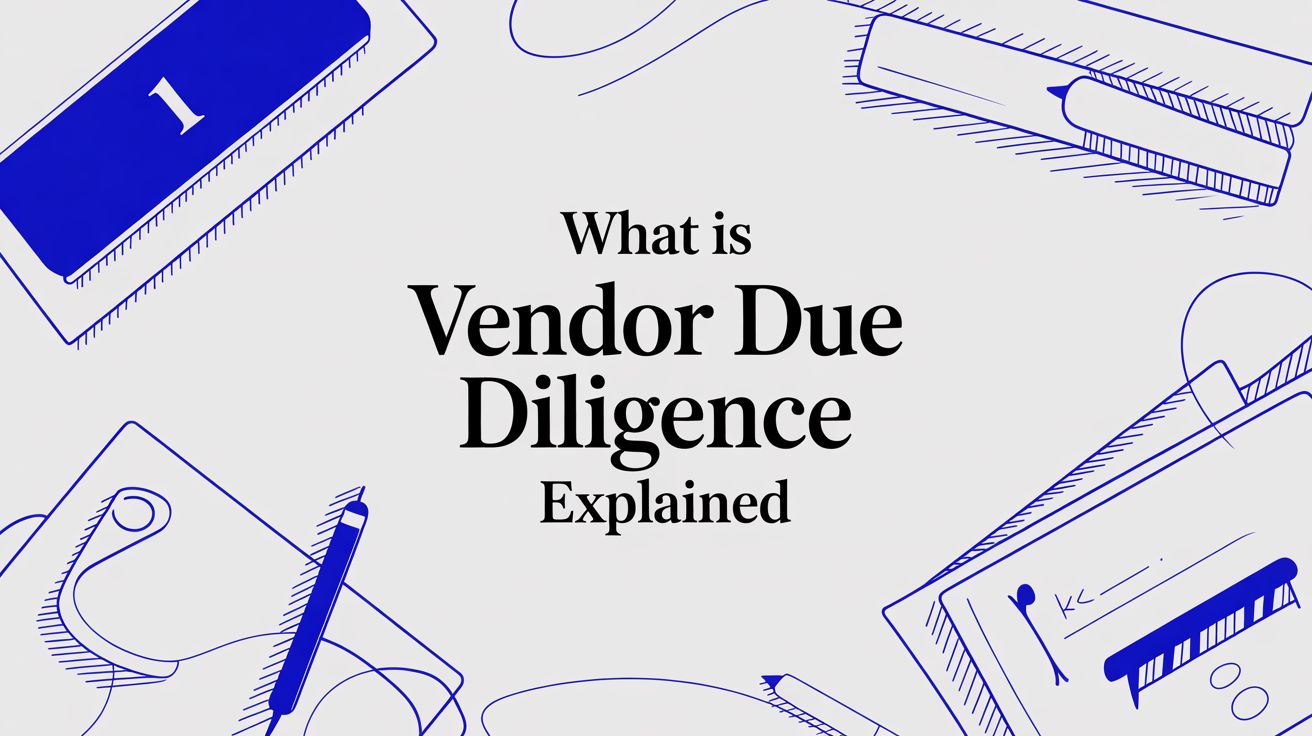· Jane Iamias · best practices knowledge management · 23 min read
10 Best Practices Knowledge Management Teams Need in 2025
Discover the top best practices knowledge management teams use to answer security questionnaires fast. Actionable tips on governance, AI, and workflows.
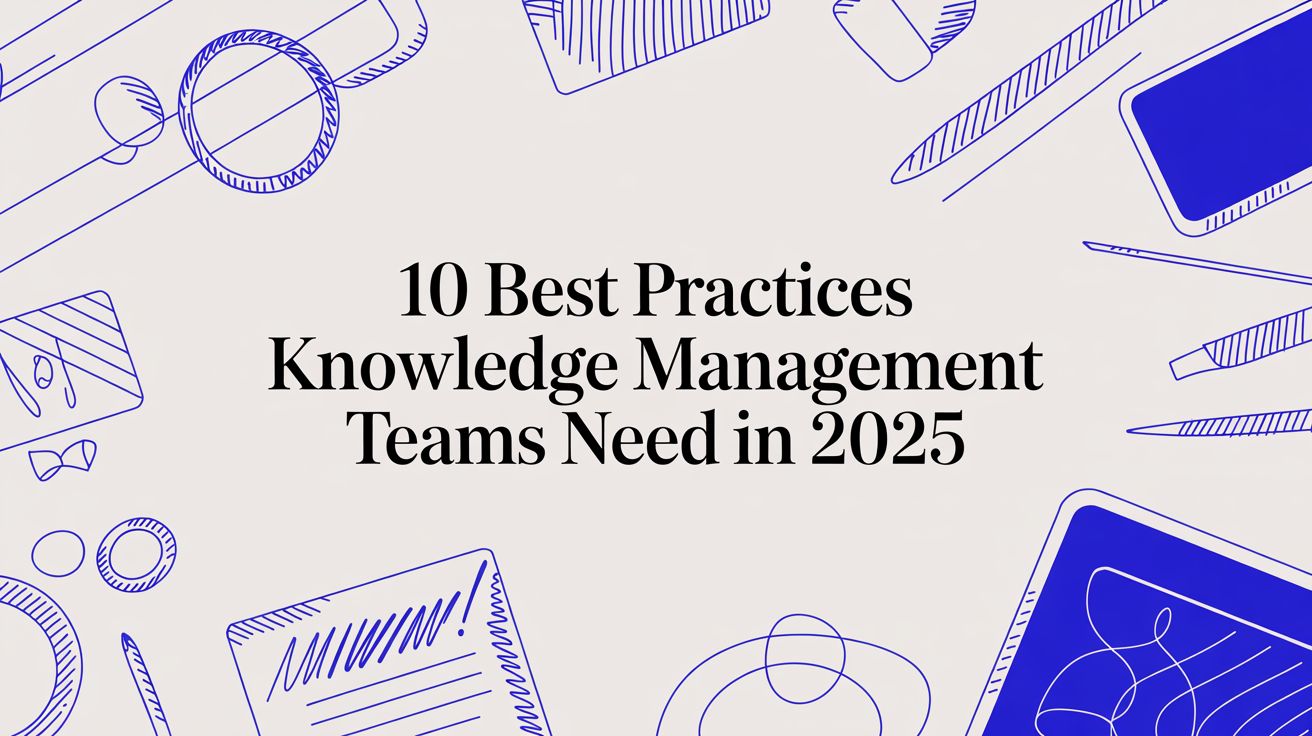
In today’s fast-paced sales cycles, the ability to respond to security questionnaires quickly and accurately is no longer optional-it’s a critical deal-closer. Teams often find themselves drowning in repetitive questions, scrambling to find the latest policy documents, and struggling with inconsistent answers that put valuable contracts at risk. The root of this problem isn’t a lack of effort; it’s a breakdown in knowledge management. A robust, well-organised knowledge base is the engine that drives rapid, reliable security responses.
This article moves beyond generic advice to provide a prioritised roundup of the top ten best practices knowledge management professionals use to conquer security questionnaires. We will explore actionable strategies for everything from structuring your knowledge base and ingesting sources to implementing robust governance and leveraging AI for automation. You will learn how to build a centralised, single source of truth that empowers every member of your team, from sales engineers to compliance managers.
By adopting these methods, your organisation can transform a painful, time-consuming task into a streamlined, strategic advantage. The goal is to equip you with the tools and frameworks needed to build a resilient knowledge ecosystem, ensuring you never lose a deal to response delays again. We will cover specific, practical techniques for implementation, providing a clear roadmap to enhance your team’s efficiency and accuracy. This guide is your blueprint for turning security questionnaire responses from a bottleneck into a core business asset.
1. Establish a Single Source of Truth with a Centralised Knowledge Base
The cornerstone of any effective knowledge management strategy is a centralised, meticulously organised Knowledge Base (KB). For teams tackling security questionnaires, this isn’t merely a shared folder; it’s a dynamic, single source of truth for all compliance-related information. This approach eliminates the frantic, time-wasting searches across siloed platforms like SharePoint, email threads, and Slack conversations, which often lead to the use of outdated or inconsistent answers.
A single source of truth ensures every team member, from sales engineers to compliance managers, draws from the same pool of vetted, up-to-date knowledge. This guarantees consistency and accuracy in every questionnaire response, reinforcing trust with prospects and customers.
How to Implement a Centralised KB
Building a truly effective central repository requires more than just choosing a platform. Success depends on structure and governance from day one.
- Choose the Right Tool: Select a dedicated knowledge base platform (e.g., Confluence, Notion, or specialised security questionnaire tools) that supports robust search, version control, and access management. Avoid generic file storage like Google Drive, which lacks the necessary metadata and search capabilities.
- Define a Clear Structure: Organise content logically. A practical structure for security teams might be categorising information by compliance frameworks (e.g., ISO 27001, SOC 2, GDPR) or by security domains (e.g., Access Control, Encryption, Incident Response). This allows for quick navigation to relevant policies, procedures, and architectural diagrams.
- Establish Ownership: Assign clear owners to specific sections of the KB. For example, the Head of Engineering might own the “System Architecture” section, while the GRC Manager owns the “Policies and Procedures” area. This accountability is crucial for keeping information current and accurate.
Key Insight: A centralised KB isn’t a “set it and forget it” project. It’s a living system that requires continuous curation and governance to remain the authoritative source. Without clear ownership and review cadences, it quickly becomes just another disorganised data dump.
2. Cultivate Expertise Through Communities of Practice (CoP)
Beyond a static knowledge base, one of the most dynamic best practices in knowledge management involves fostering Communities of Practice (CoP). These are self-organising groups of individuals, united by a shared domain of expertise, who collaborate to solve problems, share insights, and innovate. For security questionnaire response teams, a CoP could bring together security architects, compliance analysts, and sales engineers to collectively deepen their understanding of evolving threats and new compliance controls.
This approach transforms knowledge management from a top-down, document-centric activity into a living, peer-to-peer exchange. It decentralises expertise, empowering team members to learn from one another’s experiences in real-time. Instead of just consuming documented answers, they are actively involved in creating and refining them, ensuring the knowledge is practical, relevant, and battle-tested.

How to Implement Communities of Practice
Successfully launching a CoP requires deliberate cultivation and organisational support. It is less about rigid management and more about creating an environment where shared learning can flourish.
- Provide Dedicated Resources: Allocate specific time for CoP activities, such as monthly deep-dive sessions or a dedicated Slack channel. Support from leadership is crucial; this signals that peer-to-peer learning is a valued part of the work, not a distraction from it.
- Establish a Clear Domain Focus: Define the community’s purpose clearly. For instance, a CoP could focus on “Cloud Security for AWS” or “Responding to GDPR-related Questionnaires”. This focus ensures discussions are relevant and productive, while still allowing flexibility for members to explore related topics.
- Appoint a Facilitator: Designate a facilitator or “community champion” to maintain momentum. This individual isn’t a manager but a guide who organises meetings, sparks conversations, and helps document key insights that can be fed back into the central knowledge base.
- Document and Share Insights: Ensure the valuable knowledge generated within the CoP doesn’t stay locked within the group. Create a simple process for documenting key takeaways, novel solutions, and best practices, and integrate them into the single source of truth for the wider organisation to benefit.
Key Insight: A Community of Practice thrives on social interaction and shared purpose, not formal hierarchy. Its power lies in creating a safe space for practitioners to ask difficult questions, share successes and failures, and collaboratively build a deeper pool of collective knowledge than any single expert could develop alone.
3. Implement Mentorship and Knowledge Transfer Programmes
While a digital knowledge base captures explicit information, much of an organisation’s most valuable security expertise is tacit, residing in the experience of senior team members. Mentorship and knowledge transfer programmes are designed to systematically capture and share this expertise, ensuring critical insights are not lost during personnel changes and that junior colleagues can handle complex security questions effectively.
This structured approach transforms informal advice into a strategic asset. For teams responding to security questionnaires, this means less experienced members can learn the nuances behind policies, understand historical context for architectural decisions, and develop the critical thinking needed to address non-standard queries. This is a core component of sustainable, best practices knowledge management, building resilience and capability across the team.
How to Implement Mentorship and Knowledge Transfer
A successful programme requires more than simply pairing up employees. It needs clear goals, structure, and organisational support to thrive.
- Define Clear Objectives: Set specific, measurable goals for the programme. A key objective for security teams could be “reduce the time for a junior analyst to independently complete a standard questionnaire by 40% within six months” or “document three critical, unwritten security processes per quarter”.
- Structure the Relationship: Provide a framework for interactions. This could include guidelines on meeting frequency, suggested topics (e.g., reviewing a recent complex questionnaire, deep-diving into a specific security domain like Incident Response), and tools for tracking progress. This structure ensures accountability without being overly rigid.
- Train Your Mentors: Being a subject matter expert doesn’t automatically make someone a good teacher. Provide mentors with training in effective coaching, active listening, and constructive feedback techniques. This equips them to transfer their knowledge more effectively and build a stronger rapport with their mentees.
Key Insight: Mentorship programmes are the most effective defence against knowledge loss from staff turnover. By formalising the transfer of tacit knowledge, you create a living archive of expertise that a static document could never capture, ensuring team continuity and a deeper level of shared understanding.
4. After-Action Reviews (AAR) and Retrospectives
Effective knowledge management is not just about storing existing information; it’s about actively generating and capturing new insights from experience. This is where After-Action Reviews (AARs) and retrospectives become invaluable. These structured sessions, popularised by the U.S. Army and the Agile community, provide a formal mechanism for teams to reflect on completed projects or security incidents, ensuring hard-won lessons are captured and integrated into the knowledge base.
For teams handling security questionnaires, an AAR after a particularly challenging RFP can uncover process bottlenecks, content gaps in the Knowledge Base, or communication breakdowns. By systematically examining what happened, why it happened, and how to improve, organisations can avoid repeating mistakes and continuously refine their response strategy. These reviews are a cornerstone of a learning culture, transforming reactive problem-solving into proactive improvement. You can learn more about creating after-action reports following security incidents.
How to Implement AARs and Retrospectives
Successfully integrating AARs requires a commitment to psychological safety and structured facilitation. The goal is collaborative learning, not assigning blame.
- Schedule Promptly: Conduct the review as soon as possible after an event or project completion while memories are still fresh. For security incidents, this should be a mandatory part of the closure process.
- Establish a Blameless Culture: The facilitator must set the tone that the review is about process, not people. Frame the discussion around systemic improvements. This encourages honest participation from all levels.
- Document and Integrate Findings: The output of an AAR is not just a conversation; it’s actionable knowledge. Document key takeaways, assign action items for updating policies or KB articles, and track them to completion. To ensure accuracy and reliability of your knowledge assets, establishing an efficient documentation review process is paramount.
Key Insight: The true value of an After-Action Review is realised when its findings are translated into tangible updates within your central knowledge base. A review without documented outcomes and follow-up actions is just a meeting; an AAR with integrated learnings is a powerful engine for continuous improvement in knowledge management.
5. Implement Robust Knowledge Governance and Stewardship
A centralised knowledge base is only effective if its contents are trustworthy and current. This is where knowledge governance comes in, establishing the formal policies, roles, and processes needed to manage information throughout its lifecycle. For teams handling security questionnaires, strong governance is non-negotiable; it ensures that every answer is not just found quickly, but is also accurate, approved, and compliant.
Effective governance transforms a knowledge base from a passive data repository into a dynamic, reliable system. It defines who is responsible for creating, validating, updating, and ultimately archiving knowledge assets. This framework prevents knowledge decay, ensures consistency across responses, and provides a clear audit trail for compliance purposes, which is essential for regulated industries like finance and healthcare.
How to Implement Knowledge Governance
Successful governance requires a deliberate approach that balances control with usability, making it easy for people to do the right thing.
- Define Clear Roles and Responsibilities: Assign specific stewardship roles. For instance, a Product Manager might own technical specifications for their features, while a Compliance Analyst is responsible for validating answers against SOC 2 controls. This creates a web of accountability that maintains the integrity of the entire knowledge base. For more details on structuring these duties, you can learn more about defining roles, responsibilities, and authorities.
- Establish a Knowledge Lifecycle Policy: Document clear processes for content creation, periodic review, updates, and archival. For example, implement a rule that all knowledge assets related to security controls must be reviewed and re-validated every six months or after any significant system change.
- Develop a Content Standardisation Guide: Create and enforce templates for different types of knowledge, such as security policies, architectural diagrams, or standard questionnaire answers. This ensures every entry has a consistent structure, format, and level of detail, making information easier to consume and use correctly.
Key Insight: Governance should be an enabler, not a bottleneck. The goal is to build guardrails that make it simple for contributors to provide high-quality information, not to create a bureaucratic process that discourages participation. Automate review reminders and use templates to make compliance the path of least resistance.
6. Storytelling and Narrative-Based Knowledge Sharing
Beyond policies and technical specifications, effective knowledge management captures the context and nuance of real-world security challenges. Storytelling transforms abstract compliance concepts into memorable, relatable narratives. For teams responding to security questionnaires, this means embedding the “why” behind a control, not just the “what,” making the knowledge more impactful and easier to recall under pressure.

Sharing a case study about a successfully mitigated phishing attempt, for instance, provides a powerful, contextual answer to questions about security awareness training. This narrative-based approach helps team members internalise best practices, moving beyond rote memorisation to a deeper understanding of the organisation’s security posture.
How to Implement Narrative-Based Knowledge Sharing
Integrating storytelling into your knowledge management requires a structured process for capturing and sharing these valuable experiences.
- Create Story Templates: Standardise the collection of narratives to ensure they are useful and consistent. A template could include sections for the initial challenge, the actions taken, the specific security controls applied, the outcome, and the lessons learned. This structure makes it easier for others to contribute and consume the knowledge.
- Source Diverse Narratives: Actively seek stories from different departments, not just the security team. A sales engineer might share a story about how a specific security feature helped close a deal, while an engineer could narrate a post-mortem from a minor security incident. This provides a holistic view of security in practice.
- Index and Tag Stories for Discovery: Make these narratives easily discoverable within your knowledge base. Tag stories with relevant keywords like “phishing,” “incident response,” “access control,” or the associated compliance framework (e.g., ISO 27001). This allows team members to quickly find a relevant story to support a questionnaire answer.
Key Insight: Storytelling is not about embellishment; it’s about providing context and meaning. A well-told, factual story about a security event or a customer success journey can communicate the effectiveness of your controls far more powerfully than a dry policy statement ever could.
7. Foster Collaborative Knowledge Creation with Wikis
Static documents managed by a single gatekeeper are a bottleneck in fast-moving organisations. A more dynamic approach is to foster a culture of collaborative knowledge creation using wiki-style platforms. For teams responding to security questionnaires, this means empowering subject-matter experts across the company to contribute, edit, and refine knowledge in real time. This democratises the creation process, ensuring that information is captured directly from the source.
By adopting a wiki model, you transform your knowledge base from a read-only archive into a living, evolving ecosystem. An engineer can directly update a technical control description, or a legal team member can refine a data privacy statement. This collective ownership ensures the content is more accurate, comprehensive, and up-to-date than what a single knowledge manager could ever achieve alone.
How to Implement a Collaborative Wiki
A successful wiki is built on clear guidelines and active participation, not just the technology itself. True success lies in creating a system where contribution is easy and encouraged.
- Establish Clear Contribution Guidelines: Define who can create and edit content and what the approval process looks like. Use templates for common entry types, such as security controls or policy summaries, to maintain a consistent structure and ensure all necessary information is included from the start.
- Assign Section Stewards, Not Gatekeepers: Instead of a single owner, assign “stewards” to specific domains (e.g., Infrastructure, Application Security). Their role is to facilitate contributions and review for accuracy and clarity, not to be the sole authors. This is a key element of effective knowledge management best practices.
- Promote Active Curation: Encourage team members to link between related pages, tag articles with relevant keywords (e.g., “GDPR,” “encryption,” “SOC 2”), and flag outdated content for review. This peer-driven maintenance keeps the knowledge base organised and trustworthy over time.
Key Insight: A collaborative wiki thrives on engagement, not just technology. Its value is directly proportional to the ease with which experts can share their knowledge. If contributing is difficult or bureaucratic, your wiki will quickly fall into disuse and become just another neglected information silo.
8. Externalise Tacit Knowledge into Explicit Documentation
A significant portion of an organisation’s security expertise resides in the minds of its senior engineers, compliance experts, and architects. This “tacit knowledge” - intuition, experience, and unwritten know-how - is invaluable but also highly vulnerable. The systematic process of externalisation converts this expertise into explicit, documented knowledge, making it a permanent, accessible asset for the entire team.
For teams facing security questionnaires, this means capturing the why behind a security control, not just the what. Documenting the decision-making rationale, historical context, and nuanced implementation details ensures that knowledge survives employee transitions and empowers junior team members to answer complex questions with authority and accuracy. This is a core pillar of sustainable, best practices knowledge management.
How to Implement Knowledge Externalisation
Successfully capturing tacit knowledge requires a structured, multi-faceted approach that goes beyond simple Q&A sessions. It involves deliberate processes to translate expertise into reusable documentation.
- Prioritise High-Risk Knowledge: Identify subject matter experts (SMEs) who are single points of failure or nearing retirement. Focus initial efforts on capturing their unique knowledge related to critical security domains, such as system architecture, incident response playbooks, or the reasoning behind specific policy exceptions.
- Use Diverse Capture Methods: Rely on more than just interviews. Use shadowing sessions to observe how an expert solves a problem, facilitate workshops to diagram complex processes, and encourage SMEs to “think aloud” while performing tasks. This combination captures not only procedures but also the underlying thought processes.
- Structure the Documentation: Create standardised templates for capturing this knowledge. A template for a security control might include fields for the control’s purpose, implementation details, historical context (e.g., “We chose this method after a previous tool failed”), and common follow-up questions from auditors. This structure ensures consistency and usability.
Key Insight: The most valuable explicit knowledge includes the context and rationale behind a decision. Documenting why a specific encryption algorithm was chosen or why an access control policy is structured a certain way is far more powerful than just stating the policy itself. This context is critical for defending security postures in questionnaires.
9. Learning and Development Integration with Knowledge Management
True knowledge management transcends static repositories; it evolves into a dynamic ecosystem that fosters continuous improvement. Integrating your Learning and Development (L&D) programmes with your knowledge management initiatives creates a powerful feedback loop. This strategic alignment ensures that knowledge is not just stored but is actively applied, refined, and used to build competencies across the organisation.
For teams managing security questionnaires, this means training is directly linked to the practical knowledge needed for their roles. New security analysts learn not just the theory of compliance but how to find and apply the specific, vetted answers within the knowledge base. This approach transforms the KB from a passive library into an active learning tool, accelerating onboarding and deepening expertise.
How to Implement L&D Integration
Aligning learning with knowledge management requires a deliberate, structured approach that connects theoretical training to practical application.
- Map Competencies to Knowledge Domains: Begin by identifying the core competencies required for roles involved in the security response process. Map these competencies directly to specific sections of your knowledge base. For example, a “Data Encryption” competency for a sales engineer should link to the KB articles detailing your company’s encryption standards and policies.
- Create Learning Pathways: Develop structured learning pathways within your L&D platform (e.g., LinkedIn Learning, Coursera) that guide employees through relevant knowledge base content. A new GRC analyst’s pathway might include modules on ISO 27001, followed by a task to review and summarise the corresponding policies in the central KB.
- Establish Feedback Loops: Create formal channels for insights gained in the field to inform and update both the knowledge base and L&D content. If the sales team frequently encounters new questions about a specific security control, this feedback should trigger both a KB update and a micro-learning module to address the knowledge gap company-wide. This forms a core part of your security awareness and training programme.
Key Insight: Integrating L&D with knowledge management shifts the focus from simple information retention to demonstrated capability. The ultimate goal isn’t just that an employee knows where to find an answer, but that they have the competence to understand, apply, and improve that knowledge in their daily work.
10. Foster a Culture of Knowledge Sharing and Continuous Improvement
Tools and processes are only half the battle; the most sophisticated knowledge base will fail without an organisational culture that values and incentivises knowledge sharing. For teams responding to security questionnaires, a supportive culture transforms knowledge management from a bureaucratic task into a collective responsibility. This means creating an environment where curiosity, continuous learning, and transparency are not just encouraged but are fundamental to how the team operates.
A strong knowledge management culture ensures that insights from a difficult questionnaire don’t just disappear after submission. Instead, they are captured, refined, and fed back into the central knowledge base, making the entire team smarter and more efficient for the next request. This shift from individual knowledge hoarding to collective intelligence is one of the most impactful best practices in knowledge management.
How to Cultivate a Knowledge-Centric Culture
Building a culture requires deliberate and sustained effort, driven by leadership and reinforced through organisational systems. It’s about changing mindsets and daily behaviours.
- Secure Executive Sponsorship: Leadership must visibly champion the importance of knowledge sharing. When a CTO or CISO actively uses the knowledge base and praises team members who contribute, it sends a powerful message that this work is valued.
- Align Incentives and Recognition: Incorporate knowledge sharing contributions into performance reviews and career progression. Publicly celebrate individuals who update outdated content, document new processes, or help colleagues find information. This makes sharing a recognised and rewarded activity.
- Create Safe Spaces for Learning: A crucial part of knowledge creation is experimentation and even failure. Encourage teams to conduct post-mortems on difficult questionnaires, not to assign blame, but to identify knowledge gaps and process improvements. This psychological safety encourages honest feedback and learning.
Key Insight: A knowledge-sharing culture cannot be mandated; it must be nurtured. It grows from consistent leadership modelling, positive reinforcement, and embedding collaborative behaviours into the core fabric of your team’s identity, making it a natural part of everyone’s daily work.
Top 10 Knowledge Management Practices Comparison
| Approach | 🔄 Implementation complexity | ⚡ Resource requirements & speed | ⭐ Expected outcomes | 📊 Ideal use cases | 💡 Key tips |
|---|---|---|---|---|---|
| Knowledge Management Systems (KMS) Implementation | High — complex integration, governance & customization | High resources; time-to-value 3–6 months | ⭐⭐⭐⭐ Centralized access, consistency, reduced search time | Large enterprises needing a single source of truth; regulated environments | Pilot, enforce governance, designate stewards, integrate with workflows |
| Communities of Practice (CoP) | Low–Medium — informal setup but needs facilitation | Low resources; time-to-value 6–12 months | ⭐⭐⭐ Peer learning, innovation, increased engagement | Cross-functional knowledge sharing, professional communities | Provide time/resources, appoint facilitators, document and share outputs |
| Mentorship and Knowledge Transfer Programs | Low–Medium — coordination and matching required | Low–Medium resources; time-to-value 3–6 months | ⭐⭐⭐⭐ Tacit knowledge transfer, retention, leadership development | Onboarding, succession planning, role-specific skill transfer | Train mentors, set clear objectives, match carefully, track outcomes |
| After-Action Reviews (AAR) and Retrospectives | Very Low — simple process but requires skilled facilitation | Very low resources; immediate to 1 month | ⭐⭐⭐⭐ Rapid learning, mistake prevention, continuous improvement | Post-project learning, incident reviews, agile teams | Ensure psychological safety, document lessons, assign follow-up actions |
| Knowledge Governance and Stewardship | Medium–High — policy, roles, compliance frameworks | Medium–High resources; time-to-value 2–4 months | ⭐⭐⭐⭐ Ensures quality, compliance, accountability of knowledge assets | Regulated industries, sensitive data environments, enterprise KM | Balance control with access, train stewards, automate compliance checks |
| Storytelling and Narrative-Based Knowledge Sharing | Low — low tech complexity but requires storytelling skill | Low–Medium resources; time-to-value 1–3 months | ⭐⭐⭐ Improves retention, context, and emotional engagement | Change communication, culture-building, complex contextual lessons | Use templates, multimedia, index stories, include diverse perspectives |
| Collaborative Knowledge Creation and Wikis | Low–Medium — platform setup plus moderation & structure | Low–Medium resources; time-to-value 1–2 months | ⭐⭐⭐ Fast content creation, diverse input, continuous updates | Teams needing frequent updates, technical docs, internal knowledge bases | Set contribution guidelines, assign owners, use tags and periodic audits |
| Externalization and Explicit Knowledge Documentation | Medium — structured capture processes and validation | Medium resources; time-to-value 2–6 months | ⭐⭐⭐ Preserves institutional memory, scalable distribution of expertise | Retirements, critical roles, SOP and process documentation | Prioritize high-risk knowledge, use templates, include context and rationale |
| Learning and Development Integration with KM | Medium–High — cross-functional design and alignment needed | Medium–High resources; time-to-value 3–6 months | ⭐⭐⭐⭐ Builds capability, ensures applied learning and sustained KM use | Skill development tied to KM, leadership pipelines, capability building | Map competencies to knowledge, use microlearning, measure application in work |
| Knowledge Management Culture and Change Management | High — long-term cultural transformation & leadership buy-in | Medium–High ongoing resources; time-to-value 6–24 months | ⭐⭐⭐⭐ Sustainable KM adoption, improved collaboration and innovation | Organization-wide KM adoption, cultural transformation initiatives | Secure executive sponsorship, align incentives, celebrate sharers, measure culture progress |
From Reactive Firefighting to a Strategic Advantage
Navigating the complex landscape of security questionnaires requires more than just ad-hoc answers and last-minute scrambles. It demands a systematic, intelligent approach to organisational knowledge. We have explored ten fundamental best practices knowledge management pillars, moving from foundational elements like implementing a robust Knowledge Management System (KMS) and establishing clear governance, to cultivating a dynamic culture through Communities of Practice, mentorship, and collaborative creation. Each practice, from the tactical precision of After-Action Reviews to the strategic integration of learning and development, offers a pathway to transform your response process from a chaotic, reactive burden into a streamlined, strategic asset.
The core message is clear: effective knowledge management is no longer a ‘nice-to-have’ administrative function. For teams on the front line of sales, security, and compliance, it is the engine of efficiency and the bedrock of customer trust. By meticulously documenting explicit knowledge, fostering a culture of continuous learning, and creating clear lines of stewardship, you build an institutional memory that is both resilient and responsive.
Your Actionable Roadmap to Knowledge Mastery
Embarking on this journey doesn’t require a complete organisational overhaul overnight. The key is to start small, build momentum, and demonstrate value quickly. Here is a practical sequence of next steps you can take today:
- Conduct a Knowledge Audit: Begin by identifying your most urgent pain points. Are you struggling with inconsistent answers? Is finding the right SME a constant bottleneck? A simple audit will illuminate where to focus your initial efforts.
- Prioritise One or Two Practices: Select the practices that will deliver the most significant impact with the least friction. For many, this starts with establishing a centralised KMS and defining a clear governance framework. This creates the foundation upon which all other practices can be built. To move beyond simply reacting to challenges and truly harness your organizational intelligence, understanding the core principles of an effective knowledge management system is essential. For a deeper dive, consider this resource: How Knowledge Management Systems Turn Chaos into Clarity.
- Champion the Cause and Secure Buy-In: Identify key stakeholders and articulate the tangible benefits: faster sales cycles, reduced SME burnout, improved answer accuracy, and a stronger security posture. Use early wins as evidence to build broader support across the organisation.
- Embrace Technology as an Accelerator: Modern AI-powered platforms are designed to catalyse this transformation. They provide the structure for a well-organised knowledge base, automate the tedious task of drafting initial responses, and enforce governance standards like source citation and review workflows. This technology frees your team from low-value tasks, allowing them to focus on strategic, high-impact work.
The Ultimate Pay-off: A Competitive Edge
Ultimately, mastering these best practices knowledge management principles is about more than just answering questionnaires faster. It’s about building a learning organisation that consistently captures, refines, and redeploys its collective intelligence. It’s about empowering your sales engineers to respond with confidence, assuring your prospects with accuracy, and enabling your security team to focus on proactive defence rather than reactive paperwork.
The transition from a state of constant firefighting to one of strategic control is a powerful one. It turns a significant operational drain into a distinct competitive advantage, accelerating revenue and solidifying your reputation as a trusted, secure partner. The journey begins now, with a single, deliberate step towards building a smarter, more connected organisation.
